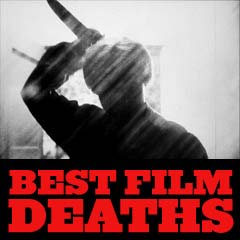
|
Deaths Scenes 1999 |


|
Director Sam Mendes' Best Picture-winning film opened with voice-over narration of mid-life crisis-suffering suburbanite Lester Burnham (Kevin Spacey) revealing:
The film's ending was still a shock when the death actually played out. Lester narrated the film's final lines, during which a gunshot sounded in the Burnham kitchen. He described some of the meaningful experiences of his life (with a montage of images, some black and white from the past) - and despite his death, he expressed his feelings of "gratitude for every single moment of my stupid little life":
Lester was shot in the back of the head as he looked wistfully at a family photography in the kitchen, reacting: "Man, oh man." The gun slowly appeared on the right side of the frame, and the white-tiled kitchen wall to the left of the frame was splattered with blood and brains, sailing in the air over a vase of red roses after the gunshot. Daughter Janie (Thora Birch) and her boyfriend Ricky Fitts (Wes Bentley) were the first to see the blood and body. Ricky stared quizzically at the sight. Lester's voice-over narration began, returning to a few seconds before the fatal gunshot. In the Burnham home's bathroom, teenaged Angela (Mena Suvari) turned toward the sound of the first gunshot (Lester had aborted an attempted seduction of her only moments earlier). Following the gunshot, the next door neighbor - retired Marine Col. Frank Fitts (Chris Cooper) rushed into his home, where he was shown breathing heavily and with blood on his white T-shirt. His gun rack showed one missing weapon. Fitts - a self-loathing, latent homosexual, felt shamed that he had earlier misinterpreted Lester's friendship in the garage and had kissed him. Lester told Fitts: "I'm sorry, you got the wrong idea."
Undoubtedly, Lester was murdered by Colonel Fitts - not by his real estate agent wife Carolyn (Annette Bening) (who at the same time removed a gun out of the car's glove box and said to herself: "Lester, I refuse to be a victim"). |
  The Misinterpreted Kiss: Lester and Col. Fitts  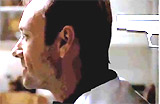   Lester Burnham Murdered in Kitchen |
|||||||||

|
Boys Don't Cry (1999) The controversial, true-to-life lesbian romantic film by director Kimberly Peirce, originally rated NC-17, dramatized the story of a 21 year-old transgendered male (anatomically female) who became the violent focus of retribution and murder in Nebraska in December of 1993. Female-to-male transgendered, cross-dressing Teena Brandon/Brandon Teena (Hilary Swank), in a sickening scene, was shot at point-blank range in the chin by jealous ex-convict John Lotter (Peter Sarsgaard). After Brandon slumped to the floor, John stabbed Brandon's lifeless body before fleeing. Brandon's blonde white-trash factory worker/girlfriend Lana Tisdel (Chloe Sevigny) helplessly screamed and watched in horror and was almost shot herself. The next morning, the film ended with the voice-over reading of a letter sent by Brandon to Lana, mentioning their future together, as Lana drove away:
|
    Shot and Stabbed 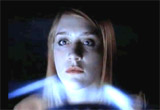
Lana Tisdel |
|||||||||

|
Deep Blue Sea (1999) In this science-fiction thriller by director Renny Harlin, research was being conducted on mako sharks, to alter their DNA and make them more intelligent - and of course, deadlier and swifter. Financier Russell Franklin (Samuel L. Jackson) arrived at the research facility to witness demonstrations of major test results. He suffered a surprising demise, while speaking to a group, when he was attacked by a genetically-engineered, angry killer mako shark. He was interrupted, mid-sentence, during his delivery of a rousing call-to-survival monologue to the survivors of the underwater research station. A gigantic set of jaws appeared behind him and chomped down on his helpless body:
|
  Giant Shark Attack |
|||||||||
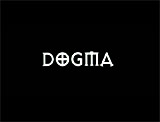
|
Dogma (1999) Writer/director Kevin Smith's imaginative yet controversial fantasy comedy with fanciful theological ideas was about a monumental struggle or race between good and evil regarding the fate of Earth and mankind. On one side were two fallen, ousted or banished angels, who had been exiled to eternity at an airport in Wisconsin:
After they discovered a loop-hole in Catholic doctrine (plenary indulgence) that would allow them back into heaven, they decided to make their way to St. Michael's Church that was being rededicated in Red Bank, New Jersey - to have their sins forgiven. They would participate in a revamped 'Catholicism Wow!' program announced by hip Catholic Cardinal Glick (George Carlin), who replaced the traditional "Scary" crucifix with a "Buddy Christ" effigy. If successful by crossing the church's threshold, they could reenter the kingdom of heaven, prove the fallibility of God and destroy the universe by nullifying all of human and earthly existence. Pompous, regenade Cardinal Ignatius Glick was delivering a speech on the steps of the church, when Bartleby stepped up, pushed through the crowd, and threatened the assembled parishioners:
Bartleby twisted Officer McGee's (Robert Holtzman) head to the right to break his neck ("Mr. McGee, don't make me angry. You wouldn't like me when I'm angry"), causing a riot. He spoke above the tumult's screams:
A panicked TV reporter issued a statement about the proceedings:
The exterior of the church was seen littered with massacred bodies, as slacker Jay (Jason Mewes) asked: "Then what the f--k are we supposed to do? Just wait for a solution to fall out of the sky?" On cue, the Cardinal's decapitated body plummeted out of the sky and landed splat at their feet. With his wings cut or torn off, Loki (now restored to humanity) emerged and identified the headless corpse:
Slightly later, Bartleby flew back to the scene, threatening and warning to kill more: "Soon a cadre of police will arrive just in time to kill us as we exit the church. Then this failed experiment called existence will cease to be." Loki stood up and resisted ("This has gone too far, I might have to take you down"), but Bartleby fatally stabbed Loki as he held him close, mentioning that he was now a weakly mortal with a "short life span":
It was decided to stall Bartleby from going into the cathedral. Jay used a machine-gun to shoot off the angel's wings (to make him fully mortal), after shouting: "Ready for the counting game? Count the shells, Suck-a-Duck." Bartleby triumphantly laughed, since now he had been made human and could re-enter Heaven once he died. However, he didn't think about other consequences - he would be punished as a sinner for murder - and go to Hell. Later, when Bartleby attempted to enter the Church, God (Alanis Morissette) appeared and mercifully killed him with the power of Her Voice, while bringing back to life all those he had killed. |
 Catholic Cardinal Glick (George Carlin) Delivering Speech   Bartleby in the Crowd, Twisting Officer McGee's Head   Massacred Bodies, Including Decapitated Cardinal Glick  Bartleby Returning   Loki Stabbed by Bartleby  Bartleby Laughing |
|||||||||

|
The Green Mile (1999) After The Shawshank Redemption (1994), director Frank Darabont's second prison film - with supernatural qualities - was set in the 1930s at the Cold Mountain Correctional Facility in Louisiana, where its "Death Row" was nicknamed 'The Green Mile' because of the floor's faded lime-green linoleum. There were two especially gruesome executions using "Old Sparky," an antiquated electric chair. Doomed prisoner Eduard 'Del' Delacroix (Michael Jeter) was the victim of a botched prison execution (by electric chair) in which his flesh was literally fried when it caught on fire as he slowly and painfully died. Sadistic guard Percy Wetmore (Doug Hutchinson) had deliberately sabotaged the execution by not wetting the sponge used to quickly and efficiently conduct the electricity into Delacroix' body. This execution was followed in the film's conclusion by another inmate execution - the doomed, noble illiterate, mystical child/giant and faith healer - black condemned convict John Coffey (Michael Clarke Duncan). He was being punished for an alleged crime (the rape/murder of two young white girls) that he didn't commit. He calmly accepted the execution, and as he was being prepared, he sang from the movie Top Hat (1935):
Head death row prison guard Paul Edgecomb (Tom Hanks) agreed that a required black hood wouldn't cover his head, because he feared the dark. Edgecomb pronounced: "May God have mercy on your soul," and then hesitated for a long time before giving the fatal order. He first shook Coffey's hand as he remembered his words, spoken in voice-over: "He kill them wi' their love. That's how it is every day, all over the world."
|
    Delacroix's Botched Execution   Prison Guard Paul Edgecomb |
|||||||||
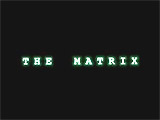
|
The Wachowski Brothers' popular science-fiction action film conjectured that the futuristic world's reality was actually a simulated dream world (called the Matrix) - a massive artificial intelligence system. At the same time, sentient machines had imprisoned and subdued almost the entire human population (except for a few rebels) in the year 2199 in order to use human body heat and brain neural activity as energy sources. The rebel's Nebuchadnezzar hovercraft was about to be assaulted by robotic Sentinels in just a few moments in the real world, at the same time that messianic savior Neo/Thomas Anderson (Keanu Reeves) was attempting to find an exit from the Matrix at Wabash and Lake. He was furiously pursued by a group of agents, and shot dead, point-blank, by sinister Agent Smith (Hugo Weaving) on the third floor of the Heart O' The City Hotel, outside Room 303. The cartridge shell noisily fell to the floor. Neo looked down at his bloody fingers after touching the hole in his chest. A second shot propelled him backwards into the hallway and against the wall. Smith then emptied his revolver into Neo's body and he slumped to the floor. Onboard the hovercraft in the real world, Neo's body shook as he was hit, and monitors reported that he was dead. And in the Matrix, after Neo's heartbeat was checked, an agent pronounced: "He's gone." Smith spoke: "Goodbye, Mr. Anderson," as the agents departed. His love-interest Trinity (Carrie-Anne Moss) refused to believe it - she whispered to Neo:
A kiss from Trinity's lips miraculously revived him and his vital signs returned. She commanded him: "Now get up!" Within the Matrix, his heartbeat was restored and his eyes flickered open.
Neo stood up, raised his arm, and the palm of his hand resisted more of the agents' bullets in mid-air. As the One, Neo finally understood that the bullets fired against him were not real - he saw the Matrix as it really was -- solely lines of downward-streaming computer code (or 'digital rain'). He then singlehandedly and effortlessly conquered Agent Smith's attack. When the remainder of the agents fled, Neo returned to the Nebuchadnezzar as the EMP (emergency self-destruct system) was deployed, producing a blast of white light to kill off the Sentinels. He again kissed Trinity. |
      Neo (Mr. Anderson) Shot Dead by Agent Smith in the Matrix |
|||||||||
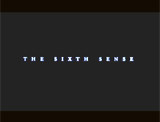
|
The Sixth Sense (1999) Writer/director M. Night Shyamalan's twisting suspenseful film about ghosts was designed as an investigation into how/why a haunted six-year old boy named Cole Sear (Haley Joel Osment) was seeing the spirits of dead people. In fact, it was a setup to fool the audience into believing that Cole's psychologist was seriously finding answers regarding Cole's secret powers. In this psychological thriller's prologue/opening, psychologist Malcolm Crowe (Bruce Willis), with his wife Anna (Olivia Williams) behind him, spoke to a strange intruder that had entered their home's bathroom: "This is 47 Locust Street. You have broken a window and entered a private residence....There are no needles or prescription drugs of any kind in this house." Anna asked: "What do you want?" She was told: "What he promised me!" Malcolm was told clues about the identity of the stranger - a disgruntled and highly-disturbed ex-patient named Vincent Grey (Donnie Wahlberg) from ten years earlier:
Malcolm responded: "I do remember you. Quiet, very smart, compassionate, unusually compassionate." Grey added: "You forgot cursed. You failed me. YOU FAILED ME!" As Malcolm apologized and offered to help, Grey turned, reached for a weapon, and shot him in the stomach. As Malcolm fell back onto the bed clutching his abdomen, Grey put the weapon to his own head and pulled the trigger (off-screen). Anna came to her husband's aid - and the screen blackened. The film's next scene was identified as "THE NEXT FALL, SOUTH PHILADELPHIA."
Although it appeared that he survived (the scene was not fully played out until the revelation of his shocking 'death' in the film's closing scene), the fact that he was a ghost-spirit functioned as the film's major plot twist. Anna noticed the bullet hole in Malcolm's shirt, and then a pool of blood oozing from underneath him. When she rolled him over on his right side, she noticed the massive and bloody exit wound on the back of his shirt. He tried to reassure her with his final words:
|
    Intruder Vincent Grey 
Shot in the Abdomen: Alive or Dead? |
|||||||||

|
Sleepy Hollow (1999) Washington Irving's early 19th century short story 'The Legend of Sleepy Hollow' was the basis for Tim Burton's horror film, with elements of dark humor. It was notable for its numerous beheadings, slashings, and decapitated bodies, including the off-screen decapitation of a child, by a fabled supernatural, jagged-toothed headless rider known as the Headless Horseman (Christopher Walken). The feared murderer, a Hessian mercenary who rode a giant black steed named Daredevil, emerged from the foot of a gnarled Tree of the Dead to terrorize the town of Sleepy Hollow. The legend was told of the butchering Headless Horseman, a Hessian mercenary, of how he had lost his own head during the Revolutionary War in the "winter of 79." He was beheaded by his own sword in the Western Woods - both his head and body were buried there and the area became "haunted" due to the "seed of evil" in the ground. The subsequent slayings in the town, investigated and often witnessed by unorthodox NYC detective Ichabod Crane (Johnny Depp), included:
The most innovative of the killings was of city leader Baltus Van Tassel (Michael Gambon), who felt he was safe in the town's church. He met his end when the horseman impaled him in the chest with a spiked projectile (a rope-tethered wooden fence post stake), while he was standing on the church's balcony in front of a large window. He was dragged backwards through the window and pulled along the ground. As he was reeled in, Baltus was pinned between two fence-posts, with his head just extending beyond the fence - outside of hallowed protection. His head was inevitably cleanly hacked off, and the severed body part rolled down a hill. |
 the Hessian Mercenary - Headless Horseman    Killing of Baltus Van Tassel |
|||||||||

|
Three Kings (1999, US/Australia) Set during the first days after the cease-fire was declared in the First Persian Gulf War in March of 1991, this David O. Russell film followed a group of American servicemen (George Clooney, Mark Wahlberg, Ice Cube, and Spike Jonze) who possessed a map (found in an enemy soldier's butt cheeks) and went after the promised treasure within Iraq - stolen gold bars that Iraq leader Saddam Hussein had acquired from Kuwait. Special Forces Green Beret Major Archie Gates (George Clooney) knowledgeably described how sepsis (infection of the blood) was the major problem with gunshot wounds during warfare. In a spectacular, powerful special effects sequence, a bullet's trajectory was followed, from its POV, from the gun barrel to its piercing and lodging into the internal organs of the victim, and releasing green bile into the abdominal cavity.
|
   
|
|||||||||
(chronological by film title) Intro | 1915-1929 | 1930-1933 | 1934-1938 | 1939 | 1940-1942 | 1943-1945 | 1946-1947 | 1948-1949 1950-1952 | 1953-1955 | 1956-1957 | 1958-1959 1960-1961 | 1962-1963 | 1964-1966 | 1967-1968 | 1969-1970 1971 | 1972 | 1973 | 1974 | 1975 | 1976 | 1977-1978 | 1979 1980 | 1981 | 1982 | 1983 | 1984 | 1985 | 1986 | 1987 | 1987 | 1988 | 1989 1990 | 1991 | 1992 | 1993 | 1994 | 1994 | 1995 | 1995 | 1996 | 1997 | 1998 | 1998 | 1999 2000-2001 | 2002 | 2003 | 2004 | 2005 | 2006 | 2007 | 2008 | 2009 | 2010 | 2011 |